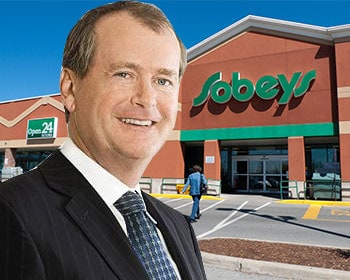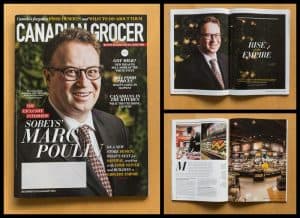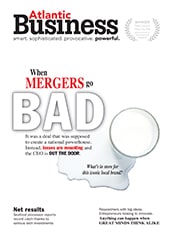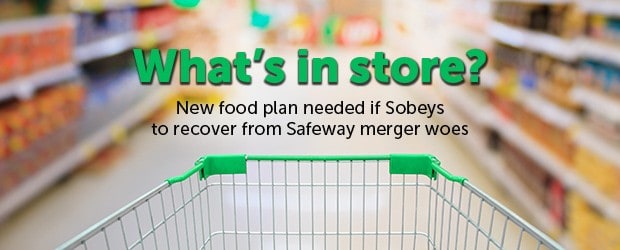The early morning conference call to discuss Empire Company Ltd.’s fourth-quarter results began as scheduled at 8 a.m. ADT, June 29, 2016. It was supposed to last an hour. Instead, the question-and-answer session plunged past 95 minutes. That’s because more than the usual number of retail stock market analysts queued up to electronically question the company’s top brass. And they had more than the usual number of questions.
That’s because the night before — just after the markets closed — Empire had released its latest financial results. The numbers were dismal. Again. Still.
Thanks largely to the ongoing, seemingly never-ending complications that Sobeys — Empire’s iconic, wholly-owned, fourth-generation supermarket subsidiary — had to deal with digesting the 2013 purchase of the Canada Safeway chain, Empire had racked up a staggering $942.6-million loss for the fourth quarter alone. The numbers for the full fiscal year highlighted even more blood-red ink: the overall net loss topped $2.1 billion. And the company had written down nearly half the value of what had been its triumphant three-year-old, $5.8-billion Safeway acquisition.
Marc Poulin, president and chief executive officer for both Sobeys and Empire, acknowledged the obvious. “Clearly, a very disappointing quarter for our organization,” he told the analysts. But he did his boss-best to find some fancy bows to tart up his numbers beast. Sobeys had made “progress in executing our integration plan,” he explained, management in the west was “now operational as one team” and the company was focusing on “three key areas” — pricing structure, network renewal and increasing efficiencies — “to strengthen our business across the country.”
But Poulin could offer no timeline for a return to profitability — “the stabilization and eventual return to an acceptable level of growth in our business is still going to take time” — and, worse, he had to admit the company was already detecting seismic “early evidence of a softening sales trend in other regions of the country.”
Awful seemed headed for abysmal.
“Having said that,” Poulin was quick to add cheerily, “we are confident we have the right strategy to compete in the Canadian food marketplace.”
The Canadian stock marketplace thought otherwise. David Hartley, a Credit Suisse analyst who’d sat in on the conference call, sent out a report to his clients later that day describing the latest write-down as “shocking” and pointing out Poulin’s obvious lack of a timetable “for a fix to ongoing operational and demand issues.” By the end of the week, the price of Empire Co. Ltd. shares had cliff-dropped 10 per cent.
What that meant for the Sobey family — which holds 90 per cent of Empire’s Class B shares — was that their personal fortunes had also cratered… by more than a billion dollars in less than a year!
What that meant for Marc Poulin was an end to Atlantic Canada’s highest paying corporate executive gig.
On July 8, 2016, a little over a week after the conference call, the board of directors of Empire and Sobeys issued a terse joint statement announcing Poulin had “left the companies effective immediately.”
What had gone so wrong so fast? And how will Empire fix it? And who will do the fixing? Oh yes, and who’s idea was this anyway?
***

Paul Sobey
That would be Paul Sobey. A great-grandson of the founder of what is now Canada’s second largest supermarket chain, Paul trained as a chartered accountant, worked briefly in Toronto and then returned home to Nova Scotia in 1982 to join Empire, the family holding company.
In 1998, Empire’s board named him president and CEO. That, not coincidentally, was also the year Sobeys dramatically declared its presence in Canada’s no-longer-regional-fiefdom grocery world by swallowing three-times-its-size, Toronto-based Oshawa Group for $1.5 billion, solidifying its new place as a national grocery competitor. (It’s worth noting that that merger did not roll out as smoothly as hoped either, but more on that later.)
Even as Sobeys was coming to terms with that corporate coming-of-age acquisition, Paul had begun sniffing around for other potential deals. In 2005, he lost out to Sobeys’ smaller rival, Quebec-based Metro, in a bidding war for A&P’s Canadian assets. That made the company’s next steps even more critical.
Two years later — during Sobeys 100th anniversary — Empire strategically took Sobeys private and began selling off its non-grocery-related assets in order to provide cash to fill the company’s ammunition coffers for what appeared to be last-grocer-standing battles to come. By then, Canada’s once staid food industry was in a roiling state of competitive, grow-or-die turmoil. Non-grocery retailers like discount giant Walmart Canada and Costco had already muscled in on traditional supermarket turf by adding miles of their own grocery aisles. In 2011, Target Corporation, the giant U.S. discount chain — which had also begun to devote an increasing percentage of its American shelf space to fresh produce and grocery products — would announce it had acquired more than 200 Canadian Zellers locations and would spend $1 billion to set up full-service-including-grocery shopping in Canada too. To counter that expected assault, Sobeys and its chief competitors, Metro and Loblaws, the country’s dominant supermarket chain, covetously targeted their own smaller grocery store rivals, simply hoping to maintain their own place in the food industry pecking order.
One of the companies they were all targeting was western-based Canada Safeway, the last big grocery store chain in play. With its 213 grocery stores, 199 in-store pharmacies, 62 gas stations, 10 liquor stores, four distribution centres and a dozen manufacturing facilities, Safeway would have been a prize for any of them. For Sobeys, it was more than that. Sixty per cent of Safeway’s business came from the key western cities of Winnipeg, Vancouver, Calgary and Alberta; western Canada, especially prosperous, oil-fired Alberta, was a weak link in the Sobeys’ national retail chain.
Given that Sobeys was not the only suitor for Canada Safeway — media reports at the time suggested Metro and Loblaws were also circling — Paul Sobey and his team conducted negotiations with Safeway executives in such secrecy they had their own bland code name (“London”), and executives met in nondescript hotels in cities where neither company was well known. The secrecy paid off. So too did Empire’s decision to build up its war chest by selling off its non-grocery assets. Sobeys was not only able to pay a premium to acquire Safeway but it was also able to sweeten the deal for Safeway’s American parent by making it a cash deal.
Late on the afternoon of June 12, 2013, a beaming Paul Sobey announced what he described as an “historic and transformational” $5.8-billion deal to acquire Canada Safeway, a “once-in-a-lifetime” opportunity that instantly goosed Sobeys national market share from 13 to 18 per cent, made it number one by market share in western Canada and cemented its second place spot in the national supermarket sweepstakes, still trailing Loblaws but now comfortably ahead of Metro and the rest.
Paul Sobey wasn’t the only one who thought he’d made a very good deal. Barry Schwartz, a portfolio manager with Baskin Financial, which owned more than 100,000 shares in Empire, told Reuters it was a “game-changing deal for Empire.” Michael Van Aelst, an analyst at TD Securities, called it the “strategic coup of the year.”
At the time, Sylvain Charlebois would have agreed. “It looked like an act of brilliance,” he told me recently. Charlebois, a food retails and agriculture expert, would have known. Now the dean of the faculty of management at Dalhousie University where he is also, concurrently, a professor in the agriculture department, Charlebois had co-founded Guelph University’s food institute, authored four books on global food systems and writes a blog called “Food Professor” for Canadian Grocer Magazine.
On paper, he says, the deal gave Sobeys “a huge advantage.” The chain not only finally became truly national but, “most critically,” Sobeys became powerful enough to quit United Grocers Inc. — a procurement organization for the nation’s smaller grocers, including Metro — and begin to negotiate its own, more competitive terms with its suppliers. The acquisition, Charlebois says, “left Metro in its dust.”
Except, of course, it didn’t. Charlebois chuckles. By not winning Safeway, he says today, Metro now appears to have “made the best deal it never made.”
***

Indeed.
Interestingly, Sobeys had been there before. So too, of course, have plenty of other companies, large and small. Having acquired a sought-after takeover prize, companies suddenly founder on the treacherous shoals of merging personnel, systems, cultures, customers into a new, unified, efficient, happy and profitable entity.
Following its 1998 acquisition of Oshawa, Sobeys had tried too quickly to impose a system-wide computerized inventory control system on all its stores. The system not only cacked its cash registers in the middle of the pre-Christmas rush but the various merger problems also ultimately forced the company to take a massive write-down. Sound familiar?
That time, the company almost immediately brought in a new president to right the listing corporate ship. Bill McEwan, a former senior vice president for Canada for Great Atlantic & Pacific Tea Company Limited, righted the ship — and more — sailing head to head against Loblaws, and often beating them. But then in 2012 — the year before the Safeway acquisition — McEwan resigned to deal with an ongoing but non-life-threatening health problem.
Curly-haired, bespectacled, smiling Marc Poulin, then 51, seemed his ideal successor. He’d originally joined Sobeys as part of the Oshawa Foods deal and quickly scaled the corporate ladder, overseeing Sobeys profitable Quebec operation for more than a decade before he was tapped to succeed McEwan as Sobeys president and CEO. Two years later, after a satisfied Paul Sobey decided to retire from Empire before the ink was even dry on the Safeway deal, Poulin assumed his roles there too.
Despite the problems that had followed the Oshawa takeover and despite the well documented potential for corporate disruption any change in leadership in the midst of a merger can create, Paul Sobey was not only confident Sobeys had learned its Oshawa lessons but also that Poulin was the right man for his new duties. (Sobey, who remains on the board at Empire, didn’t respond to email requests to discuss the current situation at the company. Bill McEwan too demurred “out of respect for the Sobey/Empire organization, its ownership and the people. Any Monday morning quarterbacking from me in the public domain would be neither respectful nor helpful… or well enough informed at this point.”)
Poulin seemingly made all the right early moves. He used Sobeys new marketplace clout to demand suppliers reduce their prices by one per cent and forego any dreams of price increases for 2014. He closed 50 “consistently underperforming” stores, most of them of the west coast, to streamline operations. For the same reason, he herded employees from Sobeys’ regional offices in Edmonton, Victoria and Winnipeg to Safeway’s head office in Calgary. Although Poulin himself remained based in Montreal and Sobeys corporate headquarters was still in Stellarton, N.S., Poulin spent a lot of his time out west, providing a present public face for the new regime.
Perhaps more significantly, Poulin — who’d convinced his then-new bosses in the late 1990s to maintain Oshawa’s popular IGA brand in Quebec rather than convert them to Sobeys stores — talked a similar talk about Safeway too. “We’re very pragmatic about branding,” he told the Toronto Star, explaining that customers would ultimately decide the name on the sign above the entrance. “The intention is to take the best of both worlds and build a great company.”
But then he turned around and did what far too many corporate executives do to screw up good intentions: he assumed his acquiring company’s brands, systems and processes were best for both companies — and, more significantly — for their customers.
Sobeys imposed its own back-end information technology SAP management systems on Safeway — with inevitable glitches and internal grumbles.
Less than six months after the takeover took effect, Poulin ended a popular Safeway customer loyalty program for what again seemed the best of possible corporate reasons — to help integrate those company systems. But in doing so, says Dalhousie’s Charlebois, “he disenfranchised the customer base.”
Customers felt even more disenfranchised when Sobeys then replaced Safeway’s popular traditional house brand, Lucerne, with Sobeys unfamiliar Compliments. Sobeys had done what it assumed was its best to create Poulin’s “best-of-both-worlds” approach by taste-testing competing private-label products and picking winners, but then packaged them as Compliments products. Safeway consumers weren’t buying. “Honestly,” a frustrated Poulin had told analysts on a December 2015 conference call, “we have to say we were a little bit caught off guard by the fact that we needed to work harder with the customer to get the proper adoption of the private-label program.” He never did.
And, in the age of social media, customers didn’t keep their unhappiness to themselves. Tweeted Allen R. Gibson to his 1,000-plus followers: “After about 30 years as a loyal customer, #Sobeys marketing have managed to put me off #Safeway in about 8 months. Idiots.”
To make a challenging situation worse, Sobeys also switched Safeway’s fresh produce supplier from one that had been controlled by Safeway’s American parent. The transition did not go well, and there were often empty shelves. Tweeted another unhappy customer: “Why is it every time I come to safeway things aren’t stocked #Safeway.”
Same-store sales — often considered a sign of customer loyalty — fell by 3.6 per cent in Sobeys’ western Canadian stores, dragging down Sobeys national same-store average sales into minus territory at the same time that Loblaws similar sales numbers were increasing by 2.6 percent and — more ominously — Walmart Canada’s were scampering ahead by 6.7 per cent.
Sylvain Charlebois says Empire “under-estimated just how different the Sobeys and Safeway cultures were,” and made a series of ill-considered decisions it carried out too quickly. The concept, he says, “was very good. The execution…” He pauses.
Whose fault was that?

Marc Poulin
“It boils down to leadership,” Charlebois says simply. While Bill McEwan had lived and breathed the retail food business from the inside since he was a 15-year-old boy bagging groceries in his hometown of Trail, B.C., “Marc Poulin is an actuary. He brought the value of analytics and big data into the grocery business. He analyzed the system through numbers, so human capital was not a critical part of his analysis. That was really his downfall.”
What was not Poulin’s fault, but became yet another key shove on his way out of the boardroom door was the reality that Alberta’s economy tanked just as Sobeys was trying to come to terms with its western Canadian acquisition.
Oil prices collapsed by 50 per cent and the industry quickly ran out of economy-expanding fuel, squeezing Sobeys western customers, especially in Alberta where Calgary reported its worst unemployment numbers in 20 years. Then, in part because of what was happening in the oil patch, Canada’s loonie fell back down to earth, driving up import prices for shoppers across the country. Sales at traditional grocery stores in the west, which had been chugging along at a comfortable two-or-more per cent a year increase for years, suddenly began to contract. In 2015, sales in traditional food outlets fell by one per cent in Alberta, and worse in Saskatchewan (4.2 per cent) and Manitoba (4.3 per cent). Price-weary consumers opted to buy their beans and wieners at discount operations, including Walmart, Costco and Loblaws’ own No Frills chain.
“We’re not dealing with the same customer psyche that we were dealing with even a year ago,” Poulin told analysts in March. “The behaviour of the customer in Western Canada has changed, and we have to acknowledge that.”
Complicating that issue for Sobeys was that, although it operates its own successful established discount chain, FreshCo, in Ontario, it doesn’t offer lower-priced outlets elsewhere, including in suddenly bargain-hungry western Canada. Despite changing industry economics — Canadian Grocer reports the overall market share for discount stores has risen from 34 per cent to 40 per cent since the 2008 recession, and it’s growing — Sobeys didn’t seem prepared, or agile enough, to roll out an alternative to its traditional stores in western Canada after it got hit by its Safeway-takeover/economic-meltdown perfect storm in 2015.
Converting some of its western stores to FreshCo might seem like a necessary quick fix but experts suggest that would create its own new and different problems. Sobeys would be introducing another new brand to compete against Alberta’s already established discounters like No Frills. Worse, explained Peter Chapman, a former Loblaw employee-turned-Halifax-based food-retail consultant, discount is “basically an entire new business” with its own issues and challenges. While one analyst did muse to Canadian Grocer that Sobeys should consider immediately launching FreshCo in Alberta, he stopped himself, adding the telling observation that its executives already had “more on their plate” than they could cope with.
They did — and do.
Earlier this year, Sobeys attempted to counter consumer perception that its products were too expensive by lowering prices across the board on thousands of meat and produce items, not as a one-off flyer promotion but as what a spokesperson called a “a major commitment” to lower prices for its customers.
“It’s not simple promotional fixes that will get the job done,” Poulin himself explained during that fateful June 29, 2016 conference call, “it’s more fundamental changes that will adapt the business for our customers.”
With the week, Empire’s directors had decided Marc Poulin was not the man to make those “fundamental changes,” not the man to “get the job done” — and he was gone.
Which begged the question: what now?
***

The reality that Sobeys has weathered storms in the past is no guarantee it can do so again. “It’s a very different situation today than it was in 2000 when Bill McEwan took over,” Sylvain Charlebois tells me.
The grocery marketplace has changed, is changing, and will continue to change… faster and faster.
For the first eight decades of its first century in business, Sobeys was a member in good standing of a genteel gentlemen’s club of grocery retailers who had divvied up the country into a series of never-the-twain-shall-meet regional empires. Sobeys owned the Maritimes and Newfoundland while Metro carved out Quebec, Loblaws and A&P divided Ontario and Safeway patrolled the western provinces. That changed in the 1990s when an aggressive Loblaws pushed into the Maritimes, gobbling up Sobeys’ smaller rival, Boland’s-IGA, and challenging Sobeys, then acquired Provigo in Quebec, upsetting Metro’s apple cart.
That touched off a frantic round of buying and merging, but largely within the Big Five, which became four with Metro’s acquisition of A&P in 2005, and three after Sobeys takeover of Safeway in 2013. While that multi-player chess games was playing itself out, however, new and even more powerful general-retail players began nosing into the grocery trough, turning multi-player into multi-layer. While Target Corporation’s entry into the Canadian market was an abortive disaster, Walmart Canada and Costco have been growing their grocery business at what Kevin Grier of Grier Market Analysis and Consulting calls an “astounding” rate. During the first three months of 2016, in fact, sales of food at so-called general merchandisers jumped by 11 per cent while sales at traditional grocers, by comparison, increased by just two per cent.
How will Sobeys find its place in this new and crazy-making world?
Sobeys, of course, remains a very significant player. It is, after all, still the second largest grocery retailer in the country, with 1,500 owned or franchised stores operating in every province, nearly 400 retail gas locations, 78 Lawtons pharmacies and a national network of 26 distribution centres. It employs 125,000 people and racked up revenues of $24.6 billion in fiscal 2016.
The first challenge for Sobeys new permanent president and CEO will be to “salvage the relationship” between Sobeys and Safeway, Charlebois says. “Right now, it’s not working, and it needs to work if the company is to get back on track.” Once the corporate pieces are working in sync, again, the company will need to focus on its ongoing big-picture problem.
That problem, Charlebois suggests, is that Sobeys projects a “confused brand. Loblaws has its President’s Choice, which is part of its specific vision. Metro has its focus on its own region. Sobeys…” He lets the lack of a specific core strategy or vision speak for itself.
Despite everything, however, no one is writing Sobeys off. Charlebois, for his part, remains optimistic, in large part because of the board’s tough decision to “recognize that something was wrong and make a change in leadership.”
Sobeys hasn’t survived for close to 110 years by standing pat. As former president Bill McEwan signed off his I-can’t-comment email response to me: “They will figure things out and will overcome one way or the other… as they have over so many decades. I hold all that is Sobeys in high regard.”
This story first appeared in Atlantic Business Magazine’s November-December 2016 issue.







 STEPHEN KIMBER, a Professor of Journalism at the University of King's College in Halifax and co-founder of its MFA in Creative Nonfiction Program, is an award-winning writer, editor and broadcaster. He is the author of two novels and eight non-fiction books. Buy his books
STEPHEN KIMBER, a Professor of Journalism at the University of King's College in Halifax and co-founder of its MFA in Creative Nonfiction Program, is an award-winning writer, editor and broadcaster. He is the author of two novels and eight non-fiction books. Buy his books
Well, here we are two years later, and they’re doing it again. Sobeys is delisting a lot of brands, apparently to force customers to buy their house brands. It didn’t work then, and it won’t work now. They’re pulling brands that sell well or shoving them onto lower shelves then stocking up with loads of Compliments and Sensations branded items. I have tried some of the house brands and didn’t like them. In some cases the package is lighter – I happen to like a certain amount of cereal, thank you, so smaller isn’t cheaper, it just looks that way for a moment. Their house brand rice is inferior to the brand I like. See you at Superstore.
If it was not broken, why? fix it. duhhh. should have stayed with the Safeway reward system. people, who have shopped for decades at Safeway, were put into shock. Why, for the love of God, would you openly sabotage, a system that worked for decades. No less than pissing in the eyes of thousands of dedicated employees, who were so used to doing their jobs , with minimal supervision. then destroy it by changing to a new system. In any business, its roots are founded on good employees. I know hundreds of Safeway employees, And management. Sobeys dropped the ball on this. as soon as the ink was dry. Thousands of faithfull Safeway customers were left out in the cold. and for that they will not be shopping at Sobeys. Including myself.
Good Article. My experience with Sobeys tells me that they are very inefficient and very poorly organized at a corporate level. They have far too many levels of management, and too few people willing to do the change management that may be required. This is a low margin business, and their HR / LR / IHM groups needed to be functioning well, for success. Also, trying to integrate a Non-Union Culture in Sobeys with the Safeway Union history, will face ongoing challenges, particularly since Sobeys has been very slow to effectively manage this challenge to date. They have lost many valuable and knowledgable corporate employees due to misconception, lack of vision, and lack of appropriate management. In my view, the only way they resolve the West Business Unit issues, will be if Alberta has a significant change in it’s resource based economy, which is not within Sobeys control. This is the worst company I have ever worked for, by far. They will need to close many more stores in the west, and be much more competitive and corporately efficient to survive this debacle. They believe that just selling more product at lower prices will save them, whereas a total corporate “Re-Do” is likely a better solution. Sobeys should have stayed home in the East, perhaps Safeway Inc (US) will buy back the Safeway stores at an amazingly low price and right the Safeway Brand in the West. The trend of loss has gone too far to rectify, in my view.
Great article.
No mention of the Sobeys takeover of Thrifty Foods (largely southern Vancouver Island stores, plus a few in the Lower Mainland) for $264 million in 2007. Staff morale and customer satisfaction must be in single digits now. Hard to find much that is organic (in Lotusland!) and the successful Thrifty’s house brands (including Alex Campbell’s) have been replaced by the much-resented Compliments.
Sobeys left much intact for the first couple of years, then started steadily cutting wages and hours, and squeezing out other brands for its Compliments products. They turned a beloved local chain into a charmless profit-squeezing entity. Too bad. I miss our old Thriftys and seldom shop at the Sobeys-run version.